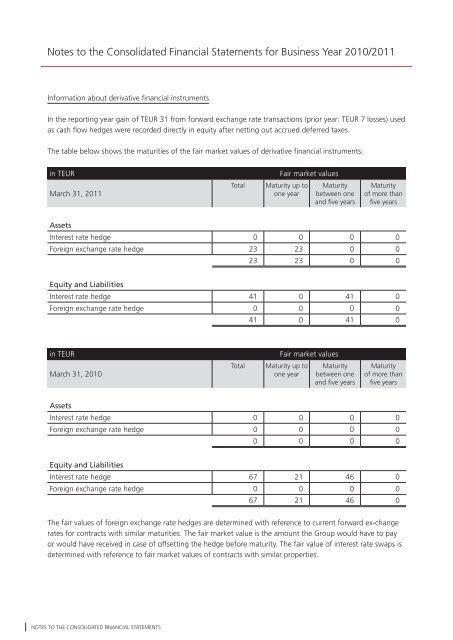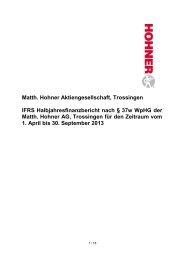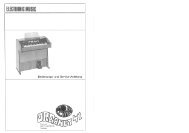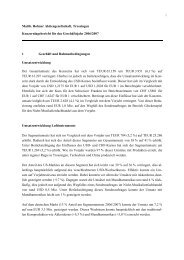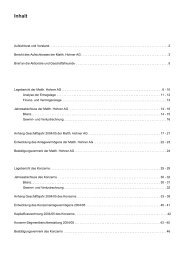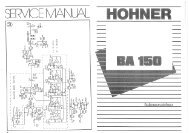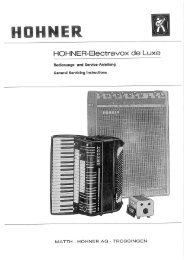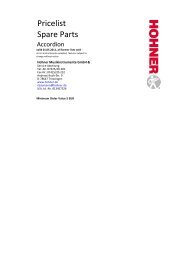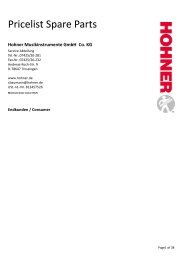Matth. Hohner AG
Matth. Hohner AG
Matth. Hohner AG
Create successful ePaper yourself
Turn your PDF publications into a flip-book with our unique Google optimized e-Paper software.
Notes to the Consolidated Financial Statements for Business Year 2010/2011<br />
Information about derivative financial instruments<br />
In the reporting year gain of TEUR 31 from forward exchange rate transactions (prior year: TEUR 7 losses) used<br />
as cash flow hedges were recorded directly in equity after netting out accrued deferred taxes.<br />
The table below shows the maturities of the fair market values of derivative financial instruments:<br />
in TEUR Fair market values<br />
March 31, 2011<br />
Total Maturity up to<br />
one year<br />
Maturity<br />
between one<br />
and five years<br />
Maturity<br />
of more than<br />
five years<br />
Assets<br />
Interest rate hedge 0 0 0 0<br />
Foreign exchange rate hedge 23 23 0 0<br />
23 23 0 0<br />
Equity and Liabilities<br />
Interest rate hedge 41 0 41 0<br />
Foreign exchange rate hedge 0 0 0 0<br />
41 0 41 0<br />
in TEUR Fair market values<br />
March 31, 2010<br />
Total Maturity up to<br />
one year<br />
Maturity<br />
between one<br />
and five years<br />
Maturity<br />
of more than<br />
five years<br />
Assets<br />
Interest rate hedge 0 0 0 0<br />
Foreign exchange rate hedge 0 0 0 0<br />
0 0 0 0<br />
Equity and Liabilities<br />
Interest rate hedge 67 21 46 0<br />
Foreign exchange rate hedge 0 0 0 0<br />
67 21 46 0<br />
The fair values of foreign exchange rate hedges are determined with reference to current forward ex-change<br />
rates for contracts with similar maturities. The fair market value is the amount the Group would have to pay<br />
or would have received in case of offsetting the hedge before maturity. The fair value of interest rate swaps is<br />
determined with reference to fair market values of contracts with similar properties.<br />
23. Segment reporting<br />
The segment information is based on the same disclosure and measurement methods as the consolidated<br />
financial statements.<br />
The criterion used as a basis for allocating the various products to the segments is the way in which they<br />
produce sound. The segmentation is following:<br />
1. Percussion instruments Drums, glockenspiels, xylophones, timpani drums, cymbals etc.<br />
2. Wind instruments Harmonicas, accordions, recorders, melodicas<br />
3. Stringed instruments Acoustic guitars, electric-acoustic guitars, electric guitars,<br />
ukuleles, banjos and guitars accessories.<br />
4. Other Pianos, digital pianos, keyboards, amplifiers, racks etc.<br />
<strong>Matth</strong>. <strong>Hohner</strong> <strong>AG</strong> assesses the performance of the segments based on the progress of gross yield<br />
(= sales revenue +/- variance in inventories - cost of materials). 100 % of the expense and income items<br />
can be directly allocated to the segments.<br />
Notes to the CoNsolidated FiNaNCial statemeNts Notes to the CoNsolidated FiNaNCial statemeNts<br />
117


